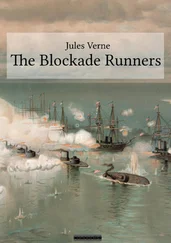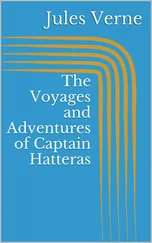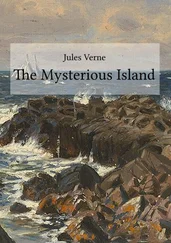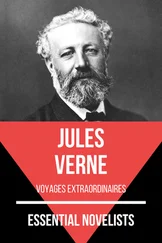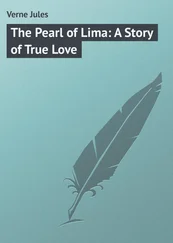“By-the-way,” put in Joe, “that reminds me of what was said by an admirer of the goodness of Providence, who praised the foresight with which it had generally caused rivers to flow close to large cities!”
At noon the Victoria was passing over a petty town, a mere assemblage of miserable huts, which once was Goa, a great capital.
“It was there,” said the doctor, “that Barth crossed the Niger, on his return from Timbuctoo. This is the river so famous in antiquity, the rival of the Nile, to which pagan superstition ascribed a celestial origin. Like the Nile, it has engaged the attention of geographers in all ages; and like it, also, its exploration has cost the lives of many victims; yes, even more of them than perished on account of the other.”
The Niger flowed broadly between its banks, and its waters rolled southward with some violence of current; but our travellers, borne swiftly by as they were, could scarcely catch a glimpse of its curious outline.
“I wanted to talk to you about this river,” said Dr. Ferguson, “and it is already far from us. Under the names of Dhiouleba, Mayo, Egghirreou, Quorra, and other titles besides, it traverses an immense extent of country, and almost competes in length with the Nile. These appellations signify simply ‘the River,’ according to the dialects of the countries through which it passes.”
“Did Dr. Barth follow this route?” asked Kennedy.
“No, Dick: in quitting Lake Tchad, he passed through the different towns of Bornou, and intersected the Niger at Say, four degrees below Goa; then he penetrated to the bosom of those unexplored countries which the Niger embraces in its elbow; and, after eight months of fresh fatigues, he arrived at Timbuctoo; all of which we may do in about three days with as swift a wind as this.”
“Have the sources of the Niger been discovered?” asked Joe.
“Long since,” replied the doctor. “The exploration of the Niger and its tributaries was the object of several expeditions, the principal of which I shall mention: Between 1749 and 1758, Adamson made a reconnoissance of the river, and visited Gorea; from 1785 to 1788, Golberry and Geoffroy travelled across the deserts of Senegambia, and ascended as far as the country of the Moors, who assassinated Saugnier, Brisson, Adam, Riley, Cochelet, and so many other unfortunate men. Then came the illustrious Mungo Park, the friend of Sir Walter Scott, and, like him, a Scotchman by birth. Sent out in 1795 by the African Society of London, he got as far as Bambarra, saw the Niger, travelled five hundred miles with a slave-merchant, reconnoitred the Gambia River, and returned to England in 1797. He again set out, on the 30th of January, 1805, with his brother-in-law Anderson, Scott, the designer, and a gang of workmen; he reached Gorea, there added a detachment of thirty-five soldiers to his party, and saw the Niger again on the 19th of August. But, by that time, in consequence of fatigue, privations, ill-usage, the inclemencies of the weather, and the unhealthiness of the country, only eleven persons remained alive of the forty Europeans in the party. On the 16th of November, the last letters from Mungo Park reached his wife; and, a year later a trader from that country gave information that, having got as far as Boussa, on the Niger, on the 23d of December, the unfortunate traveller’s boat was upset by the cataracts in that part of the river, and he was murdered by the natives.”
“And his dreadful fate did not check the efforts of others to explore that river?”
“On the contrary, Dick. Since then, there were two objects in view: namely, to recover the lost man’s papers, as well as to pursue the exploration. In 1816, an expedition was organized, in which Major Grey took part. It arrived in Senegal, penetrated to the Fonta-Jallon, visited the Foullah and Mandingo populations, and returned to England without further results. In 1822, Major Laing explored all the western part of Africa near to the British possessions; and he it was who got so far as the sources of the Niger; and, according to his documents, the spring in which that immense river takes its rise is not two feet broad.
“Easy to jump over,” said Joe.
“How’s that? Easy you think, eh?” retorted the doctor. “If we are to believe tradition, whoever attempts to pass that spring, by leaping over it, is immediately swallowed up; and whoever tries to draw water from it, feels himself repulsed by an invisible hand.”
“I suppose a man has a right not to believe a word of that!” persisted Joe.
“Oh, by all means!—Five years later, it was Major Laing’s destiny to force his way across the desert of Sahara, penetrate to Timbuctoo, and perish a few miles above it, by strangling, at the hands of the Ouelad-shiman, who wanted to compel him to turn Mussulman.”
“Still another victim!” said the sportsman.
“It was then that a brave young man, with his own feeble resources, undertook and accomplished the most astonishing of modern journeys—I mean the Frenchman Rene Caillie, who, after sundry attempts in 1819 and 1824, set out again on the 19th of April, 1827, from Rio Nunez. On the 3d of August he arrived at Time, so thoroughly exhausted and ill that he could not resume his journey until six months later, in January, 1828. He then joined a caravan, and, protected by his Oriental dress, reached the Niger on the 10th of March, penetrated to the city of Jenne, embarked on the river, and descended it, as far as Timbuctoo, where he arrived on the 30th of April. In 1760, another Frenchman, Imbert by name, and, in 1810, an Englishman, Robert Adams, had seen this curious place; but Rene Caillie was to be the first European who could bring back any authentic data concerning it. On the 4th of May he quitted this ‘Queen of the desert;’ on the 9th, he surveyed the very spot where Major Laing had been murdered; on the 19th, he arrived at El-Arouan, and left that commercial town to brave a thousand dangers in crossing the vast solitudes comprised between the Soudan and the northern regions of Africa. At length he entered Tangiers, and on the 28th of September sailed for Toulon. In nineteen months, notwithstanding one hundred and eighty days’ sickness, he had traversed Africa from west to north. Ah! had Callie been born in England, he would have been honored as the most intrepid traveller of modern times, as was the case with Mungo Park. But in France he was not appreciated according to his worth.”
“He was a sturdy fellow!” said Kennedy, “but what became of him?”
“He died at the age of thirty-nine, from the consequences of his long fatigues. They thought they had done enough in decreeing him the prize of the Geographical Society in 1828; the highest honors would have been paid to him in England.
“While he was accomplishing this remarkable journey, an Englishman had conceived a similar enterprise and was trying to push it through with equal courage, if not with equal good fortune. This was Captain Clapperton, the companion of Denham. In 1829 he reentered Africa by the western coast of the Gulf of Benin; he then followed in the track of Mungo Park and of Laing, recovered at Boussa the documents relative to the death of the former, and arrived on the 20th of August at Sackatoo, where he was seized and held as a prisoner, until he expired in the arms of his faithful attendant Richard Lander.”
“And what became of this Lander?” asked Joe, deeply interested.
“He succeeded in regaining the coast and returned to London, bringing with him the captain’s papers, and an exact narrative of his own journey. He then offered his services to the government to complete the reconnoissance of the Niger. He took with him his brother John, the second child of a poor couple in Cornwall, and, together, these men, between 1829 and 1831, redescended the river from Boussa to its mouth, describing it village by village, mile by mile.”
Читать дальше

